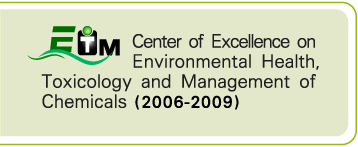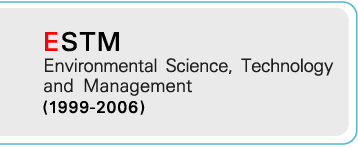|
The objective of this research was to study the use of oil palm ash as an adsorbent for chromium removal in chrome plating wastewater and in admixture for stabilization/solidification of ash-sludge. This research was divided into two parts: Firstly, it investigated the amount of oil palm ash, needed as an adsorbent for chromium removal in chrome plating wastewater. This part was a batch mode which was used to determine the optimum treatment condition with a combination of various ferrous sulfate and oil palm ash doses. The doses of ferrous sulfate were varied at 5, 10, and 20 g/L and those of oil palm ash were at 150, 200, and 250 g/L. The results showed that the chromium removal efficiency was more than 99.97% under all conditions. From the statistical analysis, the results illustrated that chromium removal efficiency did not vary with the amount of oil palm ash but it did vary depending upon the amount of ferrous sulfate. Chromium removal efficiency at the dose of 5 g/L of ferrous sulfate was higher than those at 10 and 20 g/L (P < 0.05). The optimum condition was at the use of a ferrous sulfate and oil palm ash doses of about 5 g/L and 150 g/L, respectively, resulting a chromium removal efficiency of 99.99%, and the effluent chromium concentration, pH, and SS were lower than those of the effluent standard, stipulated by the Ministry of Industry of Thailand. Secondly, it was found that the effluents chromium concentration decreased as the particle size of the oil palm ash decreased, but ferrous sulfate and oil palm ash concentrations increased. The optimum condition for chromium removal (99.99%) in chromium plating wastewater was at a particle size of 75-150 micron, ferrous sulfate at 35 g/l and a concentration at oil palm ash at about 125 g/l. The compressive strength of the solidified samples increased when the particle size of the oil palm ash, the amount of oil palm ash, ash-sludge and the water to solid (W/S ratio) decreased. However, the chromium leaching concentration decreased when the particle size of oil palm ash, the amount of palm ash and ash-sludge and the water to solid (W/S ratio) decreased. The Stabilization/Solidification of the ash-sludge mixture using cement and oil palm ash indicated that the compressive strength of all mixtures were more than those required by Thai regulatory standards for secure landfill set by the Ministry of Industry. Most of the chromium leaching concentrations was under those required by regulatory standards of Thailand. Utilization of oil palm ash for chromium sludge removal from chrome plating wastewater treatment แหล่งข้อมูล:
|
 Center of Excellence on Environmental Health and Toxicology (EHT)
Center of Excellence on Environmental Health and Toxicology (EHT)










